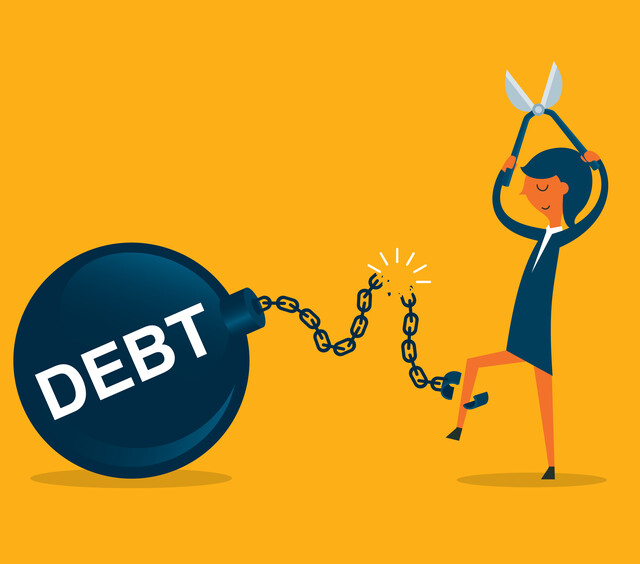Key Definitions
1. College loan � This is a loan that is designed to cover a student's college attendance fees and other costs.
2. Underemployment � This is a situation where a person's skills, availability, and experience are underutilized.
3. Gambling � This is wagering of cash in an event with an uncertain outcome with the hope of winning more money.
4. Coupon � This is a voucher that entitles an individual to a discount in a particular product.
Introduction
The 21st century generation is struggling under the weight of heavy college loans as well as other debt � a heavy load that sets it apart from the past generations. In fact, according to a recent research conducted by Pew Research Centre and which was featured in Wall Street Journal, "the young generation is changing its priorities in response to worsening economic situation, they are marrying late and moving back to live with their parents, but their debt is higher than ever."
The researchers analyzed data from Federal Reserve on debts and assets held by American households and found that the young generation is avoiding expensive buys that require long-term repayments � such as buying cars and homes � but is increasingly borrowing to fund education. The study found, "53% more young people are carrying student loan compared to the 35% in 2001.
After recording the highest debt to income rations in 2000 � during the bubble economy � people below the age of 35 shed off more debts that their older counterpart did during the great recession � largely by owning fewer cars and houses.
Between 2007 and 2010, the average debt of a household headed by a yong adult (less than 35 years) decreased by 29% compared to a lower 8% decline for households headed by adults aged 35 and above. Also, the percentage of young adults in debt fell to 78%, the least since the government started gathering such data in 1983.
The young people have reduced their debt mainly by reducing their share of cars and home ownership, but the study also showed a reducing share of the youths who reduced both credit card and other debts from 48% in 2007 to a lower 39% in 2010. On the contrary, the percentage of young people carring student loans went high from 34% in 2007 to 41% in 2010.
However, since 2010, the percentage of young people getting into the debt trap has been worrying. A 2015 report by United State (US) credit report agency stated that almost two-thirds of the youth are carry debts. In addition, their late repayments are rising, and they are more likely to default payment than older people. In fact, the report went further to state that almost half of the youths with debts have defaulted repayment, forcing the lenders to repossess their assets or charge off the debt and sell it to a collection firm. A rising number is also seeking bankruptcy protection.
High debt burdens are causing anxiety among the youth, too. In a 2014 survey done by USA Today, a newspaper published by Gannet company, and the NEFE (National Endowment for Financial Education), a non-profit organization for empowering families and individuals in US, it was found that 60 percent of all the youths in the US feel they are facing hard financial times than previous generation youths and 30 percent say they worry regularly about their debt.
"Although the number of youth aged 22 to 29 with debt has decreased, their total debt has increased by 10 percent compared to the same in 2009, to average $16,000," a study by Experian's Analysis, an organization that provides consumer credit, stated. Every kind of debt, from personal loans to college loan to credit cards, has increased. The report stated that, student-loan balances increased by 16 percent to an average of $14,000, credit cards increased by 24 percent to average $5,700, and installment loans, such as personal loans, increased by 4 percent to average $17,000.
A report by Citizens Advice, a free organization for providing advice to consumers in Northern Ireland, shows that the number of issues brought by young people to them will have tripled by the end of 2016. The report, which was published in 2015, went further to state that youth between the ages of 17-24 years went to Citizen Advice with over 102,200 debt issues in the year 2014 � a 21 percent increase from 2013. The organization says that this rise comes against a backdrop of increasing unsecured loans among the youth which put them at risk of being trapped in debt.
The organization has shown that the youths have an average of $12,000 of unsecured debt � more than 3 times what it was before the financial problem of 2006-08, and that their income to debt ratio is on the rise.
Causes of Youth Debt
Have you ever taken a moment to think about the reasons you are in debt? Have you ever scrutinized the reason behind your debt crisis? You know pretty well that debt can lead you to a disastrous future. It can consume your assets, hurt your relationships and even bring you mental stress. Here are some of the main reasons young people get into debt;
1. Reduced Income
Is your income lower than your expenses? Many youths find themselves in debt because they delay in taking care of their lives with a lower income and thus they begin to take borrow. Make sure you are living within your means.
2. Divorce
About half of all American marriage ends up in costly divorce leading to financial problems. The law in the United State governs what should be done with a family's fund during a divorce settlement. If one party demands more than what is available, the other person is forced to go into debts. Divorce has led many youths into huge debts.
3. Poor Money Management
One of the major reason young people are in debt is poor money management. In most situations, poor budgeting and planning lead to debt. With the right budget, one can easily track expenditure to make sure expenses are always less than income. If you write down all your expenses for a whole month you will see exactly where your income goes. This is the best way for the youths to understand where their income goes and avoid debt.
4. Underemployment
Young people often think that underemployment is a temporary situation, but it can have a negative effect on your future, especially if you are forced to borrow to make your ends meet. It can take decades before a debt is paid off. If you are underemployed, compute all your expenses and begin to look for a second source of income. This might reduce your chances of getting into debt.
5. Gambling
Gambling is among the beloved forms of entertainment by youths all over the world. Unfortunately, it is simply a guaranteed transfer of one's money to the gambling firm. The youths have become easily addicted to the notion of winning big as well as striking it rich that they are taking loans to gamble. Gambling can really destroy your future as you effortlessly try to win back what you lost before.
6. Medical Expenses
Expensive medical treatments and fragmented healthcare policies make medical bills one of the easiest methods to fall into deep debt. Visits to the medical world costs money and it's often a lot of money. The young people, most of whom have little or no savings, often result to borrowing to foot their medical bills. In addition, the hospitals and doctors are becoming quite impatient with individuals that do not pay their medical bills on time.
7. Little Savings
Many youths fall into debt because they are not prepared for emergency expenses by saving a few dollars. If you have little savings in your saving account, you can use it for emergencies such as a job loss, divorce or illness without raising your debt. No one has ever regretted saving money for emergencies.
8. Overspending
Young people run up their credit cards every weekend at restaurants, bars, and malls. Organizations have made it very tempting for people to spend income they do not have. Think about the buy now pay in installment offers and you will see exactly how easy it is for the young, to buy things they don't have.
9. School Loans
Going to universities or college without a clear plan of how you will pay for it can lead you into debt.
The causes of debt we have discussed above are quite common for young people and can be easy to fall into. However, there are different strategies that can help you to avoid these situations.
Avoiding and Getting Out Of Debt
When young individuals are first starting their lives, either as students or employees, debt looks like the best solution to boost their income. However, it's only a temporary fix that later sets in to drag them into the debt trap. Here are financial tips that can help you, a young person, break out of the debt trap or avoid it all together.
1. Spend Less Than You Planned
Maybe you have ever heard the saying that you can have anything you want but you simply cannot afford everything you want. Well, lucky you, many youths have dreams and wants that are ten times bigger than their income. They get into debt and remain in debt because they purchase what they want when they want it, not when they can AFFORD to. They forget that not even the richest millionaires buy everything they want.
Therefore, if you want something, do not purchase it unless you have liquid money (your money not borrowed money) to pay for it. If you learn to live on less than your income, you will have extra money to pay off your debts.
Another way to save a few dollars is to pay with cash as opposed to using credit cards. In a study conducted by McDonald's, the world's largest fast food joint, it was found that people spend 56 percent less at their restaurants when they pay with cash compared to when they pay using credit cards. In other studies, it has been shown that individuals spend 100 percent more on event tickets or at vending machines when they use credit cards. Overall, you spend at least 15 percent when you use a credit card.
For example, if we apply this notion to the average youths that currently purchases everything using credit cards to accumulate points or even get cash back, they would probably save about $3,500 every year.
2. Buy a Quality Used Car
"A new $29,000.00 car will lose about $17,000.00 of its value in the first three years," Dave Ramsey, a financial radio host. This is similar to tossing a $100 bill out of your window once per week.
The point, you can save yourself hundreds of dollars if you purchase a quality used vehicle rather than a new car.
If you wish to purchase a new vehicle, US Consumer Report has always recommended buying a reliable vehicle with a good gas economy, and then keeping it for at least 15 years. This will give you a lot of time to save for your next new vehicle.
3. Save on Groceries
To save a few dollars, stock up on groceries when they are on offer or just stockpile them when they are on sale and skip one or two groceries shopping per monthly and live off the once you piled. Ideally, buy non-perishable groceries such as cereal, canned goods, as well as things that you can freeze such as meat and bread. Doing so can save you about 25 percent on your annual bill. A young family of two or three can save about $2,900 every year.
The important thing is to watch out for sales, freezing foods properly, and stocking up when groceries are on offer. However, when you skip a grocery shop, remember that you still need to shop for perishable goods such as vegetables, fruit, and milk. Pick these on your way from work.
Additional Saving Tips
-
Always save your change � In the evening, put your change into a container.
-
Give yourself a small allowance and follow it
-
Carry only the cash you need � Unplanned spending is harder if you do not have the cash or credit to spend.
-
Whenever you want to buy something costly, wait for a few days before you buy it. Take a few days to think about it and potentially avoid making a decision you will regret later.
-
Instead of purchasing a cup of coffee daily, prepare your own. If you spend 2 dollars on a cup every day, that adds up to over $500 per year.
-
Use coupons � Coupons are easily available from different grocery manufacturers. Coupons can save you up to 10 percent on your annual grocery bill.
-
Only purchase stuff on sale if you have the cash, and only if you need the items.
-
Buy stuff when they are in low demand. For instance, vehicles of the previous make go on sale when new model roll in.
-
Shop at discount clothing stores, discount grocery stores, online stores, and dollar stores to save a few dollars. Shopping at grocery stores can save you about 10 percent on your groceries and about 32 percent on other produces.
-
Buy things that are not brand names at a discount and shop from online stores. The same producers that manufacture brand products are frequently the same producers of cheaper brands as well � this holds truly especially for vehicles, electronics, appliances, groceries, and clothing. For instance, purchasing generic brand as opposed to brand names on a grocery can save you up 25 percent. These products can save you lots of money, but they are not of the same quality standards as brand names.
-
Always shop on discount months or days. Discount months are the ideal time to buy things.

























